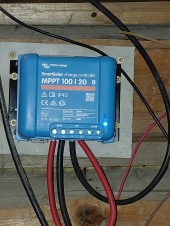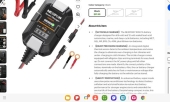Rico, a bit more information from you. What's the general location you're at? Not pinpointed, but generalized, like East Texas, or Western Washington. Design makes a big difference when you take into account your sunhours (sh), and what time of the year your sun is shining.
Can you come up with an itemized list of things you want to power? What you power, and when is as important as how many watts they consume. Items with electric motors that start under load have what's called "starting surge", or "inrush current". The inverter you select needs to be able to handle the starting surges your stuff will generate, usually 3-5X the running amperage.
For example, my well-pump, with a head of ~250 of water above the pump, has a starting surge of ~9000W for about 500 miliseconds or so. On the other hand, a free-spinning window fan in the bedroom only a starting surge of 1.1X. So, my 100W fan consumes ~110W right at startup.
This makes a big difference in the choices of inverters you select to run your house. Basically, there are two main types of inverters, low-frequency transformer based inverters, and high-frequency transformerless ones. The LF models are big, HEAVY, and expensive, but they have massive surge capacity. HF models are lighter, and much cheaper, but have almost zero starting surge capacity. Ignore whatever claim they make as to how MUCH the inverter can surge to. Pay close attention to how LONG they claim the inverter can surge to. That is the number that will make or break an inverter in terms of starting a big-ticket item like a well-pump, or shop air-compressor.
The big LF inverters typically an surge for 5-60 seconds. The HF models typically can surge for only 8-16 miliseconds, not long enough to start big motors. You definately get what you pay for with inverters. This is why the itemized list is so important.
Inverters on the market now can be divided into two styles, component, and AllinOne (AiO). Component means you need a separate charge controller, and breaker panel system to feed into the inverter. Some of the component models are LF, but cheaper component models are HF. The AiO models combine the charge controller in with the inverter in one box, making wiring more simple. Almost all AiO inverters are HF.
If you go the component route, you'll also need a charge controller. Again, they can be divided into two types, PulseWidthModulation (PWM), and MaximumPowerPointTracking (MPPT). Just skip PWM completely! They have no business being in a modern system. MPPT is vastly superior in every way except price. PWM is appropriate only for the cheapest, low budget systems. Beware though. Ebay has sellers marketing FAKE MPPT controllers. A real MPPT will have a voltage limit of at least 100V, and weigh a couple of pounds. If it says "MPPT" but only has a voltage limit of 36V, and weighs only 8oz, it's a fake.
The best solar panel deals around are local purchasing with cash and carry pickup. You pay a steep price premium to have solar panels delivered to you via shipping. Shop local venues like Craigslist for panels, and then drive over to pick them up. If you worry about panel quality, bring a voltmeter with you. Every panel has a specifications sticker on the back, listing Voc, Vmp, Isc, and Imp. With the unconnected panel just sitting out in the sun, your voltmeter will be measuring the Voc, the open-circuit voltage. Don't buy a panel if the measured Voc is more than 10% less than the published value. For example, if the published Voc = 37.5V, and you measured 35.0V, that panel is OK and good to buy. If however, you measured only 32.5V, then I'd say skip that one. It's worn out. A good deal with cash and carry panels is 4-5W/$. With shipping to your house, you won't do better than 1-2W/$.
Battery choice is becoming a religious issue. Every battery type has some kind of weakness. Traditional lead-acid dies with chronic undercharging. Small solar arrays kill lead-acid batteries. On the other hand, LI batteries can not tolerate low temperatures. They can be destroyed by placing them in an unheated shed that goes below freezing. If you buy a goodly number of panels, and charge lead-acid at 1/8th of C, they will be happy and give you long years of service. If you keep Li batteries inside a heated cabin that NEVER gets cold, then Li will be happy and give you long years of service. Let your personal situation dictate what type to chose.








